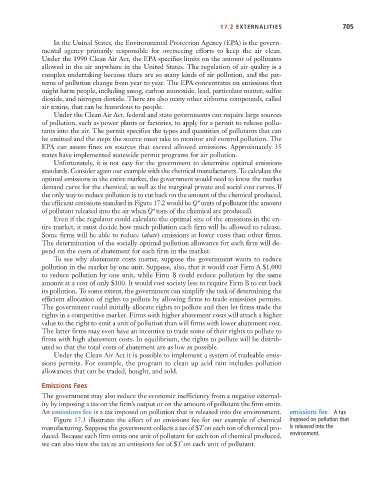Page 731 - Microeconomics, Fourth Edition
P. 731
c17ExternalitiesandPublicGoods.qxd 8/22/10 4:56 AM Page 705
17.2 EXTERNALITIES 705
In the United States, the Environmental Protection Agency (EPA) is the govern-
mental agency primarily responsible for overseeing efforts to keep the air clean.
Under the 1990 Clean Air Act, the EPA specifies limits on the amount of pollutants
allowed in the air anywhere in the United States. The regulation of air quality is a
complex undertaking because there are so many kinds of air pollution, and the pat-
terns of pollution change from year to year. The EPA concentrates on emissions that
might harm people, including smog, carbon monoxide, lead, particulate matter, sulfur
dioxide, and nitrogen dioxide. There are also many other airborne compounds, called
air toxins, that can be hazardous to people.
Under the Clean Air Act, federal and state governments can require large sources
of pollution, such as power plants or factories, to apply for a permit to release pollu-
tants into the air. The permit specifies the types and quantities of pollutants that can
be emitted and the steps the source must take to monitor and control pollution. The
EPA can assess fines on sources that exceed allowed emissions. Approximately 35
states have implemented statewide permit programs for air pollution.
Unfortunately, it is not easy for the government to determine optimal emissions
standards. Consider again our example with the chemical manufacturers. To calculate the
optimal emissions in the entire market, the government would need to know the market
demand curve for the chemical, as well as the marginal private and social cost curves. If
the only way to reduce pollution is to cut back on the amount of the chemical produced,
the efficient emissions standard in Figure 17.2 would be Q* units of pollutant (the amount
of pollutant released into the air when Q* tons of the chemical are produced).
Even if the regulator could calculate the optimal size of the emissions in the en-
tire market, it must decide how much pollution each firm will be allowed to release.
Some firms will be able to reduce (abate) emissions at lower costs than other firms.
The determination of the socially optimal pollution allowance for each firm will de-
pend on the costs of abatement for each firm in the market.
To see why abatement costs matter, suppose the government wants to reduce
pollution in the market by one unit. Suppose, also, that it would cost Firm A $1,000
to reduce pollution by one unit, while Firm B could reduce pollution by the same
amount at a cost of only $100. It would cost society less to require Firm B to cut back
its pollution. To some extent, the government can simplify the task of determining the
efficient allocation of rights to pollute by allowing firms to trade emissions permits.
The government could initially allocate rights to pollute and then let firms trade the
rights in a competitive market. Firms with higher abatement costs will attach a higher
value to the right to emit a unit of pollution than will firms with lower abatement cost.
The latter firms may even have an incentive to trade some of their rights to pollute to
firms with high abatement costs. In equilibrium, the rights to pollute will be distrib-
uted so that the total costs of abatement are as low as possible.
Under the Clean Air Act it is possible to implement a system of tradeable emis-
sions permits. For example, the program to clean up acid rain includes pollution
allowances that can be traded, bought, and sold.
Emissions Fees
The government may also reduce the economic inefficiency from a negative external-
ity by imposing a tax on the firm’s output or on the amount of pollutant the firm emits.
An emissions fee is a tax imposed on pollution that is released into the environment. emissions fee A tax
Figure 17.3 illustrates the effect of an emissions fee for our example of chemical imposed on pollution that
manufacturing. Suppose the government collects a tax of $T on each ton of chemical pro- is released into the
duced. Because each firm emits one unit of pollutant for each ton of chemical produced, environment.
we can also view the tax as an emissions fee of $T on each unit of pollutant.

